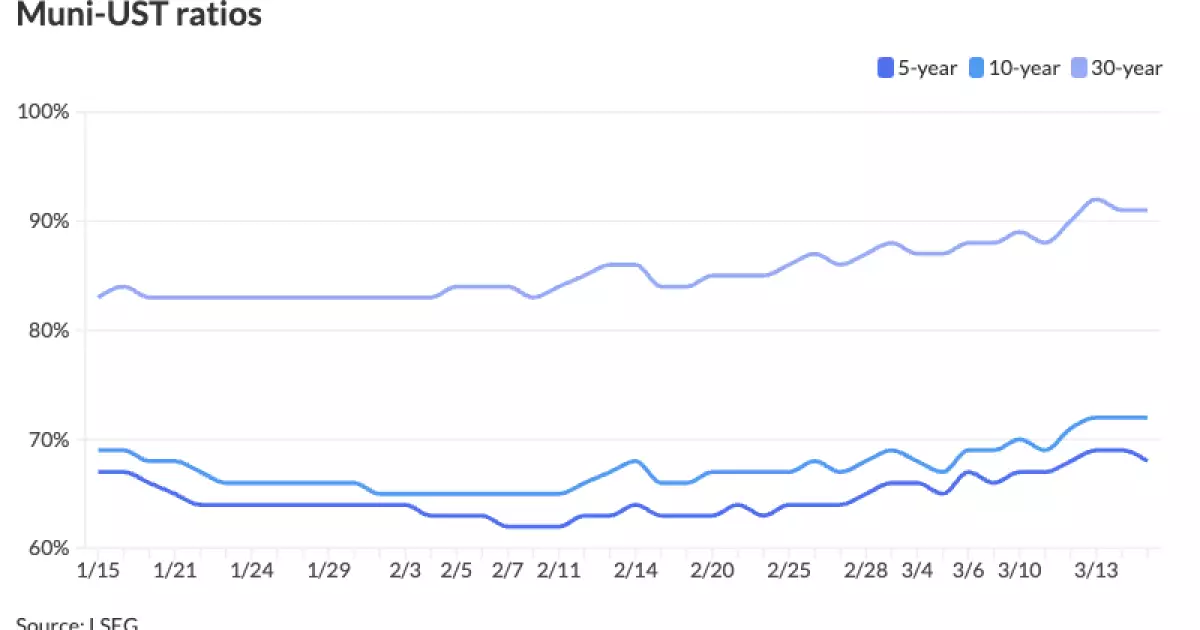The municipal bond market, often viewed as a stalwart for steady investing, is now showing signs of significant distress. Recent data suggests a troubling environment where municipal bonds are struggling to attract attention and investment. With a dismal month-to-date return of -1.41%, nearly erasing earlier gains, it has become increasingly challenging for investors seeking refuge in these typically stable securities. According to Jason Wong of AmeriVet Securities, the inherent struggles stem from a combination of issues, including a greater supply than demand, disappointing consumer price index figures, and looming fears over potential job losses due to President Trump’s tariff threats. As interest rates soar for bonds, investors might feel compelled to reevaluate their strategies.
A Flood of Supply Overwhelming Demand
The recent environment in which supply outstrips demand is concerning. Markets typically thrive on a delicate balance where both elements coexist harmoniously. In recent weeks, however, there has been an evident influx of new municipal bond issuances—16.7% higher year-over-year—meaning the market is somewhat saturated, leaving many investors wary. This deluge is compounded by a steep drop in the demand for investment-grade funds, which led to a staggering $373 million outflow from municipal mutual funds. The result has seen spikes in “customer sale lists” and a 31% increase in bid wants, indicating that investors are jumping ship in overwhelming numbers.
Investors must remain vigilant in this environment, as the plethora of issuance poses risks for existing bonds, creating downward pressure on prices and returns. As a center-right viewpoint would suggest, amid such adversity, market participants would benefit from a balanced approach—recognizing opportunities while remaining cognizant of risks.
Shifting Ratios and Market Dynamics
Amid the chaos, municipal bond ratios present a puzzling narrative—long-dated municipal ratios stand at about 90% compared to U.S. Treasuries. This peculiar valuation indicates that for the first time in over a year, munis are cheaper than their Treasury counterparts, which theoretically should trigger interest from certain buyers. However, the appetite appears muted, primarily as investors look for new issues that provide exceptional value. The two-year munis at 65% of UST yields and five-year ratios maintaining 68% present compelling entry points for discerning investors with a long-term horizon.
Nonetheless, hesitation dominates the market as volatility looms large. Currently, it’s difficult to predict whether this latest trend will reverse or simply sustain itself further. A calculated risk assessment must be adopted if investors are to capitalize on discounted long-term opportunities.
Municipal Bonds: High Interest, High Risk
Investors traditionally regard municipal bonds as low-risk assets, but the current climate increasingly resembles a high-risk environment. The average municipal yield rose substantially during the last week—imposing an average increase of 15.1 basis points. With such movements in yield, ongoing uncertainty regarding federal monetary policy, combined with fears of economic downturn, emerges as pivotal factors affecting investor sentiment.
If we embrace a center-right perspective, we must recognize the broader context: the role of government intervention through policy can often complicate market dynamics, inciting cyclical patterns of booms and busts. Investors should remain skeptical of any reliance on government assurance, as historical precedents dictate that overregulation may yield detrimental effects.
Is There Hope Ahead?
Despite the turmoil, some strategic voices within the market suggest that “investors who scoop up cheap paper in this environment will be rewarded over the longer term.” This notion stirs a sense of cautious optimism, indicating that astute investors willing to endure short-term pains may find that the potential long-term gains far outweigh the current uncertainties. The idea of capitalizing on cheaper values while the market stabilizes might provide a strategic pathway for growth-focused investors.
A robust dialogue surrounding risk appetite should dominate investor considerations. Many still view municipalities as ethically aligned investments, and if capital deployment fosters sustainable growth, it may redefine investor perceptions when the market eventually stabilizes.
As the chaos continues, investors must adeptly navigate the complex landscape of the municipal bond market, making prudent decisions that consider both short-term challenges and longer-term potential. Embracing a center-right liberal perspective could encourage innovative solutions that empower bonds while safeguarding against potential pitfalls.


Leave a Reply